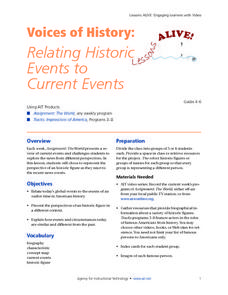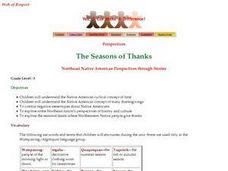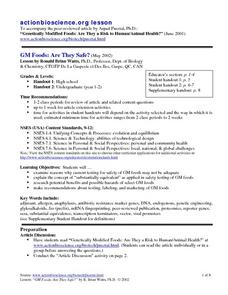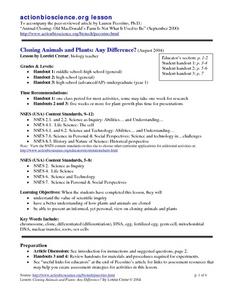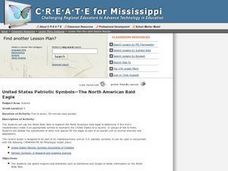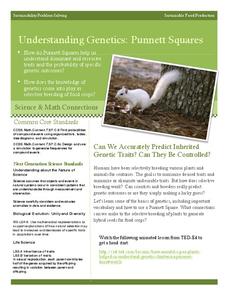Curated OER
Masks of Africa
Young scholars explain the purpose of masks to various cultures in Africa. They recognize the conceptual patterns used to create African masks and illustrate their understanding by creating their own masks
Curated OER
Rain Forests: A Disappearing Act?
Students examine and locate rainforests on maps, and research the patterns of their destruction. They develop a bar graph of rainfall and temperature data, write a journal entry, and research the people, animals, and plants/products of...
Curated OER
Lamarck And Darwin
Students compare Lamarck's mechanism for evolution with Darwin's theory of natural selection.
Curated OER
Change or Adaptation
Students identify the adaptive forces in the life cycle of plants, animals, and humans, isolate and identify the role that change and adaptation play in extreme environments and research and write a short term paper using MLA citations.
Curated OER
Liberty Vs. Safety: an American Dilemma
Students study the process of consensus and the value of studying history as we try to craft a more perfect society. They examine President Franklin D. Roosevelt's decision to incarcerate Japanese Americans in the Western United States,...
Curated OER
Dissolved Oxygen in an Aquatic Ecosystem
Students explain why dissolved oxygen is important in aquatic ecosystems. They evaluate the optimal dissolved oxygen levels for living organisms.
Curated OER
Why Is My Bread Fuzzy?
Learners explore the organisms that live on counters or surfaces in the classroom. In this mold experiment, students observe mold in different conditons. Learners record their observations on a worksheet. Students understand how...
Curated OER
Birds - Beaks and Feet
Second graders use an online database to research information about bird's beaks and feet. Using that information, they discover what foods they eat and where they live. In groups, they cluster the food/habitat and beak/feet data to make...
Curated OER
Voices of History: Relating Historic Events to Current Events
Students discuss the current events affecting the country today. In groups, they relate a historical event to a current event. They research and present the point of view of a historical figure in an interesting way. They compare and...
Curated OER
California Biodiversity
Students examine several maps of California exhibiting features such as precipitation, topography, and vegetation. They look for patterns that might be the source of or influence biodiversity in different regions. They pay particular...
Curated OER
The Seasons of Thanks
First graders explain the Native American cyclical concept of time
Curated OER
GM Foods: Are They Safe?
Students examine the process for testing GM foods. They research benefits and hazards of a selection of GM foods. They also create images of new labels and marketing for GM foods.
Curated OER
Cloning Animals and Plants: Any Difference?
Students examine the process in which plants and animals are cloned. They compare and contrast the two procedures and determine if there is a difference. They share their views on cloning to the class.
Curated OER
North American Animals
Pupils are introduced to the anatomy and characteristics of the North American wolf, grizzly bear and bobcat through a purchased kit. They cast plaster models of each of the animals for study and display.
Curated OER
Draw a Scientist
Students think to themselves about what a scientist might look like when they're working and then draw a picture of a scientist at work and discuss their drawings. They notice the number of men compared to women and other such...
Curated OER
Cypress/Tupelo Swamps
Students study the geologic history of terrain, soils, and drainage patterns. They recognize ecological processes that determine the dynamic nature of habitats. They investigate the influence of human activity on the landscape.
Curated OER
Frog Dissection
Young scholars explore the anatomy of frogs. They complete a frog dissection to complete an accompanying worksheet which includes questions, diagrams and pictures.
Curated OER
US Patriotic Symbols: The North American Bald Eagle
Students research the North American bald eagle to determine if this bird's characteristics make it an appropriate symbol to represent the United States as a country. They debate the substitution of other bird species for the eagle.
Curated OER
Cell Analogies!
Liken a cell and its organelles to a tiny person and its organs. After gathering information on cell structures and their functions, small groups collaborate to come up with an analogy of their own. They produce a collage describing the...
Curated OER
"Shooting An Elephant": George Orwell's Essay on His Life in Burma
High school readers examine George Orwell's essay "Shooting an Elephant" for examples of symbolism, metaphor, connotation, and irony. They analyze how these literary tools convey the writer's main point and contribute to the persuasive...
Curated OER
Looking Into the Mirror
Students survey the impact of racial, cultural, and/or socio-economic intolerance in their own lives in relation to other individuals. They develop written and oral proposals to solve inequality and intolerance on a local, state,...
Curated OER
Innocent or Guilty: A Lab on DNA Gel Electrophoresis
Students use the prelab as an introduction to the importance of DNA fingerprinting- a form of identification that us being accepted by both scientific and leagl experts. They prepare a gel for electrophoresis. DNA fragments, which have...
Western Kentucky University
Understanding Genetics: Punnett Squares
Can scientists really predict genetic outcomes or are they simply making a lucky guess? Scholars first learn about Gregor Mendel and how to make Punnett squares. Then they extract DNA from a strawberry in a lab with included conclusion...
Curated OER
What is Deforestation?
An overview of deforestation is the focus of this resource, which present the reader with a list of facts. Ten comprehension questions follow; learners can write their answers on a separate piece of paper. Have your environmental...










